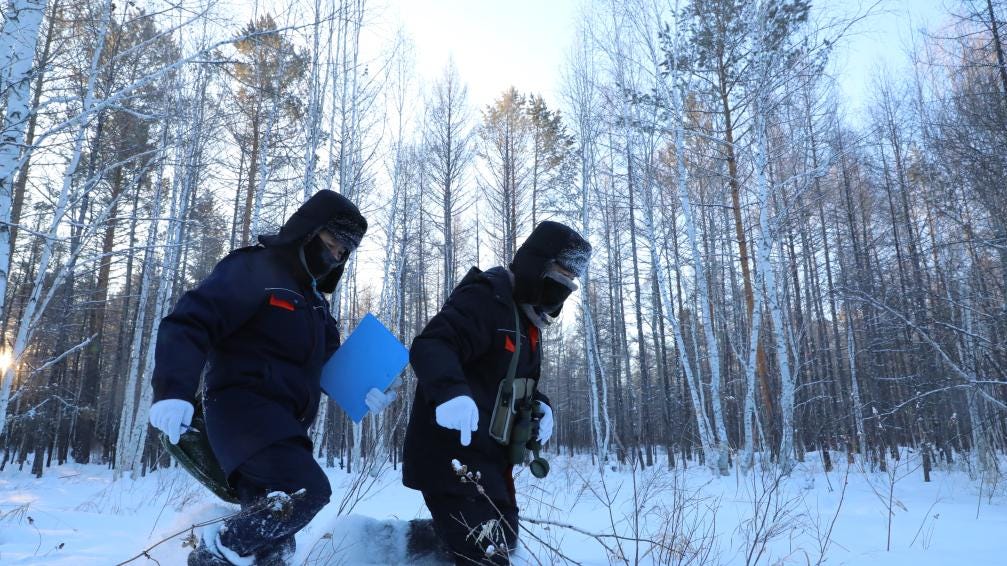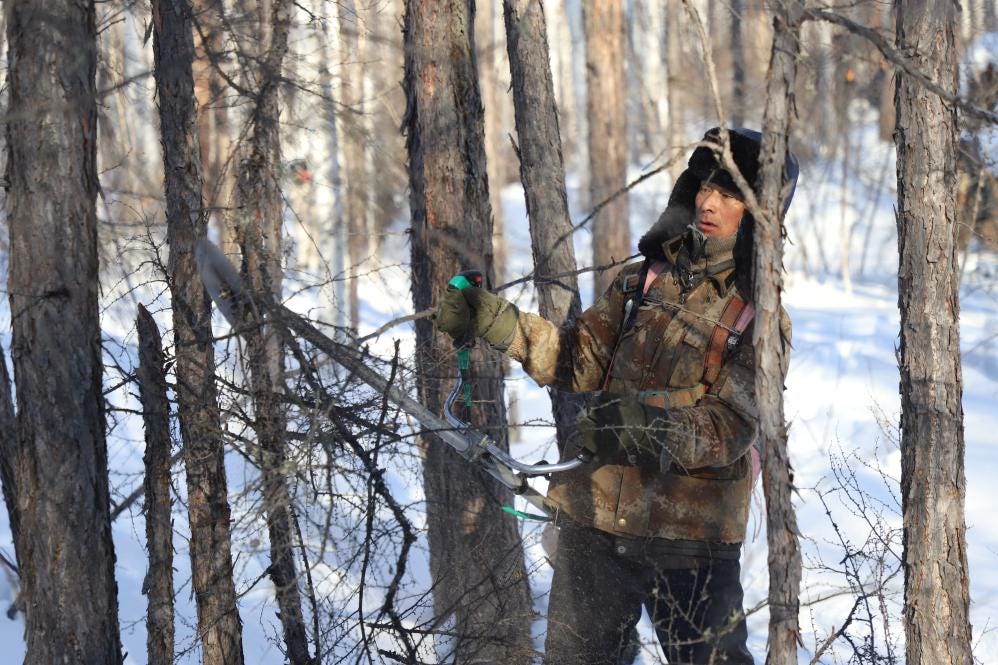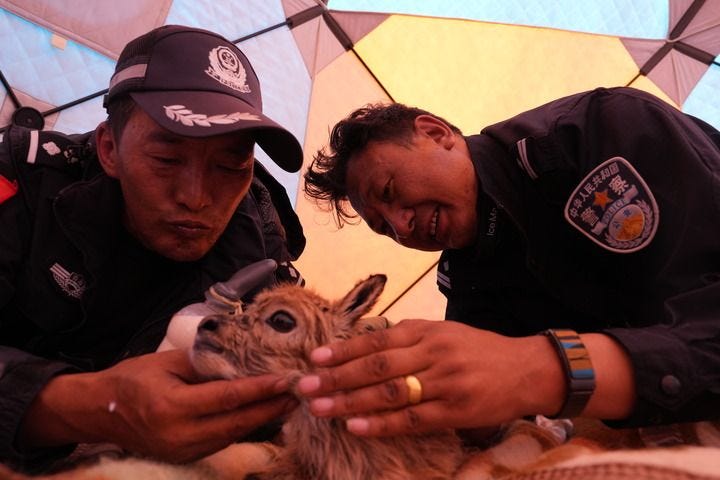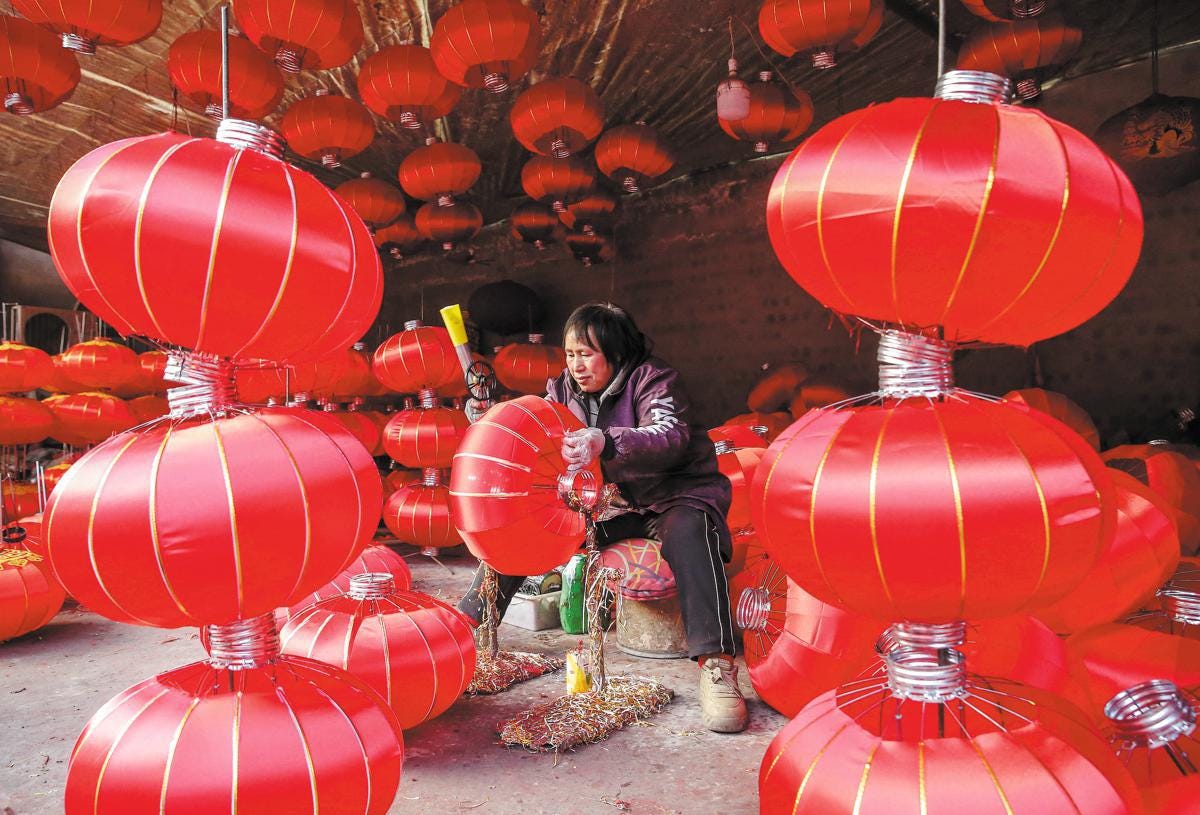The Harvest: This Week in Rural China – Dispatch No. 7 (23 January 2025)
Exploring the Intersection of Innovation, Ethics, and Environmental Challenges in China's Rural Transformation
Welcome to this week’s edition of The Harvest, your trusted source for insights into rural China’s dynamic transformation.
This week, we explore the themes and challenges defining rural China’s path forward. From the ethical dilemmas and biotechnological innovations propelling Tianjin’s livestock industry into the “Breeding 3.0” era to the opening of Hainan’s Seed Museum and its implications for ecological conservation, we examine the intersection of technology, tradition, and sustainability.
We also shed light on the extraordinary resilience of power workers in Heilongjiang’s Mohe, ensuring Arctic communities thrive through harsh winters. We analyse state media’s framing of conservation achievements in Hoh Xil as emblematic of China’s ecological ambitions. Finally, we highlight Yangzhao Village’s lantern-making tradition—a perfect example of how cultural heritage and modernisation coexist in rural revitalisation.
As always, we welcome your feedback and reflections. Feel free to share your thoughts by emailing nathan@thisweekinruralchina.com.
We hope this week’s edition offers meaningful insights into the stories shaping rural China today.
Tianjin’s Livestock Breeding Industry Enters the ‘Breeding 3.0’ Era: Precision, Profit, and Ethical Dilemmas
In an unsettling release from China’s Ministry of Agriculture and Rural Affairs, Tianjin’s livestock breeding industry has been praised for entering the newly coined “Breeding 3.0” (育种3.0) era. However, this new phase of agricultural evolution is far more than a simple refinement of existing practices; it represents a revolution driven by genomic and biotechnological innovations.
At the heart of this shift is Aoqun Animal Husbandry Company (奥群牧业有限公司), which has created a new breed of sheep. Already trialled in Xinjiang and Gansu, this breed is set to receive national recognition in 2025. It is not celebrated for any exceptional natural traits but rather for its “autonomous” breeding capabilities. This terminology, which might evoke unsettling images of self-replicating systems, underscores the central role of technology in shaping the future of animal husbandry in China.
The “Breeding 3.0” era marks a significant leap forward not only with genetically engineered sheep but also through the introduction of “core breeding groups” (核心育种群体) for pigs and breeds designed for enhanced fertility (高繁殖率). The very language used—terms like “genomic breeding” (基因组育种)—suggests an effort to bypass the unpredictable nature of biology in favour of precise genetic management. Innovations such as the “genomic selection chip” (基因组选择芯片) for meat sheep and dairy cows promise greater efficiency and higher profitability. However, these technological advancements raise serious ethical and philosophical questions about the commodification of sentient beings.
The implications of such technological developments go beyond animal breeding. The rise of “precision reproduction regulation” (精准繁殖调控) from the Tianjin Academy of Agricultural Sciences illustrates the growing influence of biotechnological methods on livestock management. Once considered speculative, these technologies are now considered critical to China’s agricultural modernisation. Genetic mapping for economically important traits positions Tianjin as a leader in molecular breeding —a field where animals are optimised not through traditional breeding but through controlled, laboratory-driven processes arriving in a world where the logistics of transporting frozen semen (冷冻精液) across provinces is now framed as a breakthrough in efficiency.
Embryo biotechnology (胚胎生物技术) is one of the most striking examples of this trend, offering greater precision in reproduction and, in many cases, higher yields. Synthetic hormones, such as FSH (Follicle-Stimulating Hormone), to stimulate embryo transplants further underscores the industry’s drive for efficiency. These technologies are viewed as steps toward a future where food production is not only abundant but carefully controlled.
Despite the undeniable progress and efficiency these technologies bring, they are not without controversy. The increasing reliance on biotechnology to secure food production raises concerns about the broader societal impacts, particularly in rural communities that are still tied to traditional farming methods. These innovations, which position Tianjin as a leader in agricultural biotechnology, risk deepening the divide between regions that embrace high-tech agriculture and those that rely on older, less efficient practices. Moreover, the ethical implications of transforming living creatures into biological data points optimised for profitability cannot be ignored.
From a broader perspective, China’s agricultural modernisation push, heavily reliant on biotechnological advancements, is framed as a crucial component of the nation’s drive for food security and economic prosperity. However, while these advancements promise enhanced productivity, there is an underlying concern that this vision may have unintended consequences. The optimism surrounding technological progress in agriculture may obscure the deeper ethical and social issues that arise from reducing nature to data points, stripping away the intimate connection between farmers and their livestock.
As Tianjin’s “Breeding 3.0” era unfolds, it is clear that the face of agriculture is changing rapidly. While the shift from traditional practices to precision agriculture might enhance food security and economic output, it is equally important to consider the potential costs: the ethical dilemmas surrounding the treatment of animals, the socio-economic impact on rural communities, and the possible detachment from nature that such technological advances might foster.
State Narratives, Power Workers and Rural Revitalisation in China’s Coldest Village
This week, Xinhua spotlighted the winter work of power engineers in Mohe, Heilongjiang, China’s northernmost district, where temperatures regularly drop below -30°C. The story highlights the conditions in which power workers ensure Beiji Village— known as China’s Arctic —remains operational through its peak winter tourist season. This report on hazardous working conditions may seem routine, but it underscores deeper narratives within China’s rural revitalisation and infrastructure investment strategies.
Mohe, with its appeal as a winter tourism destination due to the Northern Lights and “Arctic Village” tourism, heavily relies on electricity for heating, lighting, and essential services. Xinhua’s coverage emphasises the strategic importance of infrastructure in rural revitalisation efforts, particularly in remote regions where survival and economic viability depend on the resilience of power grids. The report underscores how rural areas like Mohe, once marginal in economic and geopolitical terms, are becoming focal points in China’s regional development and modernisation push.
The workers’ commitment—braving freezing temperatures, operating with essential tools, and facing hardships such as water bottles freezing mid-task—casts a spotlight on the human element driving these changes. However, this narrative is also part of a larger project that portrays the government’s role in facilitating access to essential services and maintaining control in increasingly remote territories. By framing rural workers’ sacrifices as essential to local prosperity, the state reinforces a vision of “modernised rural spaces” where development is contingent on investment in infrastructure and a newly embedded sense of community service and resilience.
The technical and social resilience demonstrated by workers like Wang Shaoting and Ma Guojun is also important. It signals the intersection of technological advancement and human effort in rural governance. The constant state media push regarding rural development efforts is not merely about infrastructure but also highlights the symbolic importance of ‘resilience’—a key theme in rural revitalisation narratives. The push to improve rural areas while modernising services often leans heavily on human capital and devotion, presenting a portrait of China’s rural future that merges modernity with the persistence of traditional roles in increasingly harsh environments.
Moreover, the state narrative embedded in this type of reporting serves dual purposes. While it portrays workers as heroic figures, it also underscores state and corporate obligations to ensure that economic development does not leave remote areas behind. However, as this emphasis grows on “connected” and “revitalised” rural regions, there are important questions about the long-term sustainability of such labour-intensive solutions in remote places. In this case, the narrative of rural resilience may need to be balanced with discussions of long-term technological solutions and automation, as human labour in such extreme conditions may only be a temporary transitional phase in the broader rural development picture.
The framing of rural workers’ struggles as integral to national pride and modernisation continues to shape the political and economic discourse around rural revitalisation. This highlights both the potential of—and challenges faced by—China’s efforts to transform its farthest corners into viable economic engines. This is part of a broader governmental messaging effort positioning rural regions as not just peripheral but vital to China’s future growth.
The Seed Museum and Ecological Innovation in Hainan
On 18 January 2025, the Seed Museum in Ding’an County, Hainan, opened its doors to the public, becoming the first museum of its kind in the region. Featuring over 800 types of seeds, the museum offers a rare opportunity to explore the ecological and agricultural significance of plant diversity across China. Located in Jiuso Village, it forms a part of Hainan’s rural revitalisation strategy, which seeks to connect agriculture, conservation and community development.
The exhibits showcase seeds from a range of ecological environments—alpine mountains, deserts, wetlands—illustrating the role of plants in maintaining ecological balance and sustaining agriculture. Among the notable exhibits is the sea coconut, the world’s largest seed. Through interactive displays, visitors learn about the critical role of seeds in food production and their potential in preserving biodiversity.
The opening event included a roundtable forum with experts from agriculture, environmental conservation and rural development. Discussions centred on how seed conservation could contribute to more sustainable agricultural practices and eco-friendly rural development. Jiuso Village is positioned to become a hub for ecological agriculture, where seed-related initiatives may protect biodiversity and foster rural tourism.
The Seed Museum also plans to offer workshops on seed planting and sustainable farming practices. By integrating education with agricultural techniques, the museum aligns with China’s broader goals of promoting organic farming and resource-efficient agriculture. Given the country’s push for agricultural modernisation, the museum’s emphasis on ecological preservation is timely, reflecting growing concerns about the environmental impact of industrial farming and the need for sustainable alternatives.
In a country like China, where agricultural policy is closely tied to both economic development and environmental concerns, the Seed Museum will serve as a critical institution supporting the dual goals of preserving biodiversity and promoting rural innovation, providing a model for integrating ecological sustainability into the broader agricultural and rural development framework.
Hoh Xil: Guardians of the Forbidden Land
This week, Chinese state media spotlighted the Tibetan antelope’s recovery in Hoh Xil, portraying the region’s rangers as national heroes. As a UNESCO World Natural Heritage Site, Hoh Xil is often held up as a model for China’s rural revitalisation and ecological preservation policies. However, this narrative reflects more than ecological success; it underscores the state’s framing of environmental protection as a source of national pride and a marker of global leadership.
Rangers endure extreme conditions to patrol this “forbidden land” (禁地), nearly 4,900 metres above sea level. A recent 27-hour journey to Sun Lake commemorated Sonam Dargye, a conservationist who was killed in 1994 while protecting the antelope from poachers. His story has since been elevated as a symbol of personal sacrifice in service of the collective good—an idea central to Party messaging on the alignment of individual duty with state priorities.
The Tibetan antelope population has increased from fewer than 20,000 in the 1990s to over 70,000 today, thanks partly to initiatives such as the National Nature Reserve Programme. However, the challenges facing Hoh Xil’s rangers remain formidable. Their work illustrates the stark realities of enforcing conservation in one of the world’s most remote and inhospitable regions, from sub-zero temperatures to hypoxia. These efforts also highlight the persistent tension between development and preservation in China’s rural frontier.
By promoting Hoh Xil’s conservation achievements, Beijing seeks to reinforce its position as a global environmental leader amid intensifying international climate discussions. However, this narrative risks overshadowing underlying conflicts. The Tibetan Plateau remains a contested space where conservation goals often collide with mining, infrastructure, and tourism development, creating trade-offs that directly impact rural communities. Hoh Xil’s story is thus as much about the complexities of modernisation as it is about ecological recovery.
Between Mountains and Waters - Photo of the Week for 23 January 2025
Lantern-Making in Yangzhao Village
This week’s photo captures the legacy of lantern-making in Yangzhao Village, Shanxi. Lantern-making in Yangzhao traces its roots to the Ming and Qing dynasties. In 2008, the craft earned recognition as an intangible cultural heritage. Today, the village blends age-old techniques with modern designs, producing handmade and foldable lanterns for festivals nationwide.










